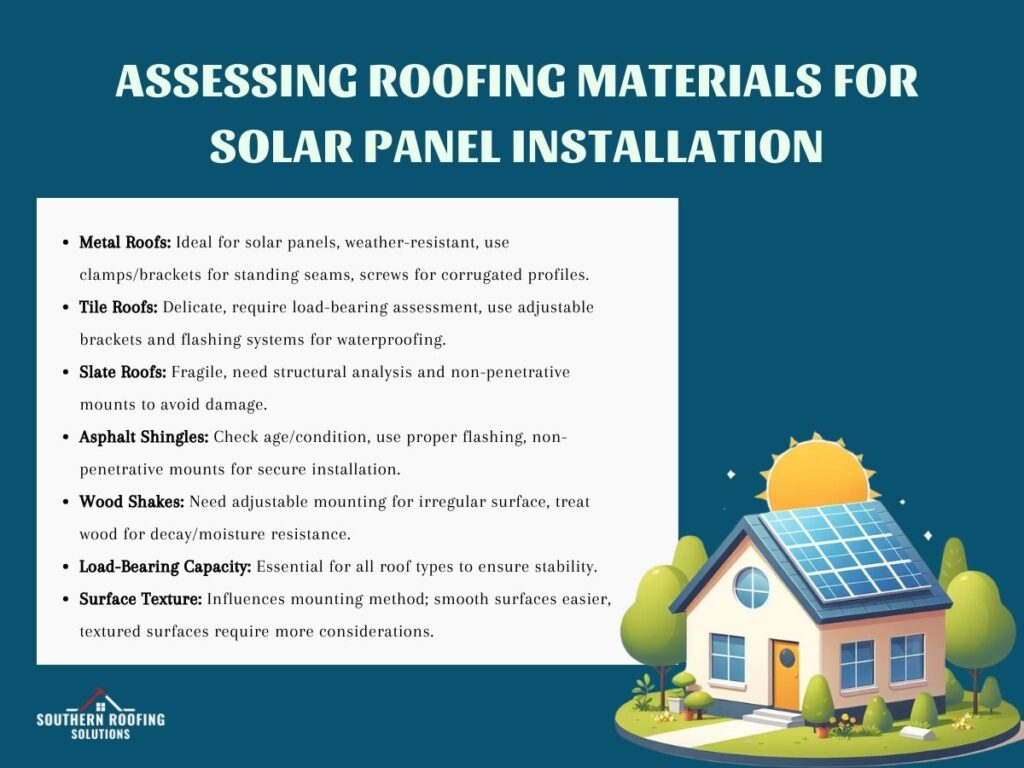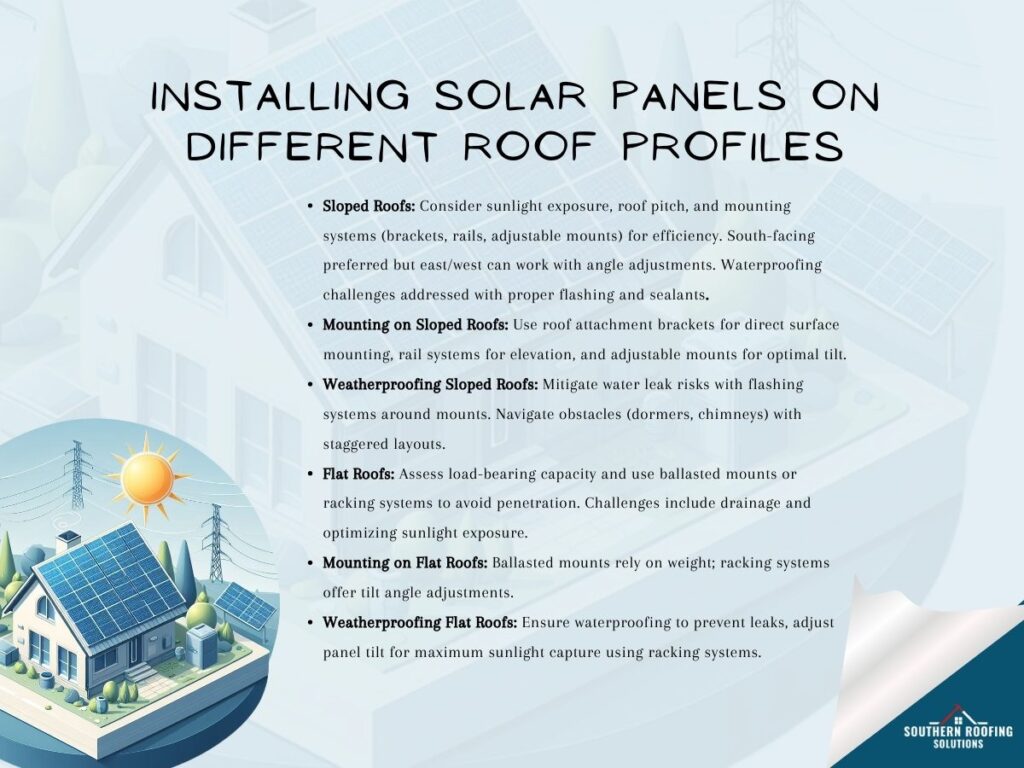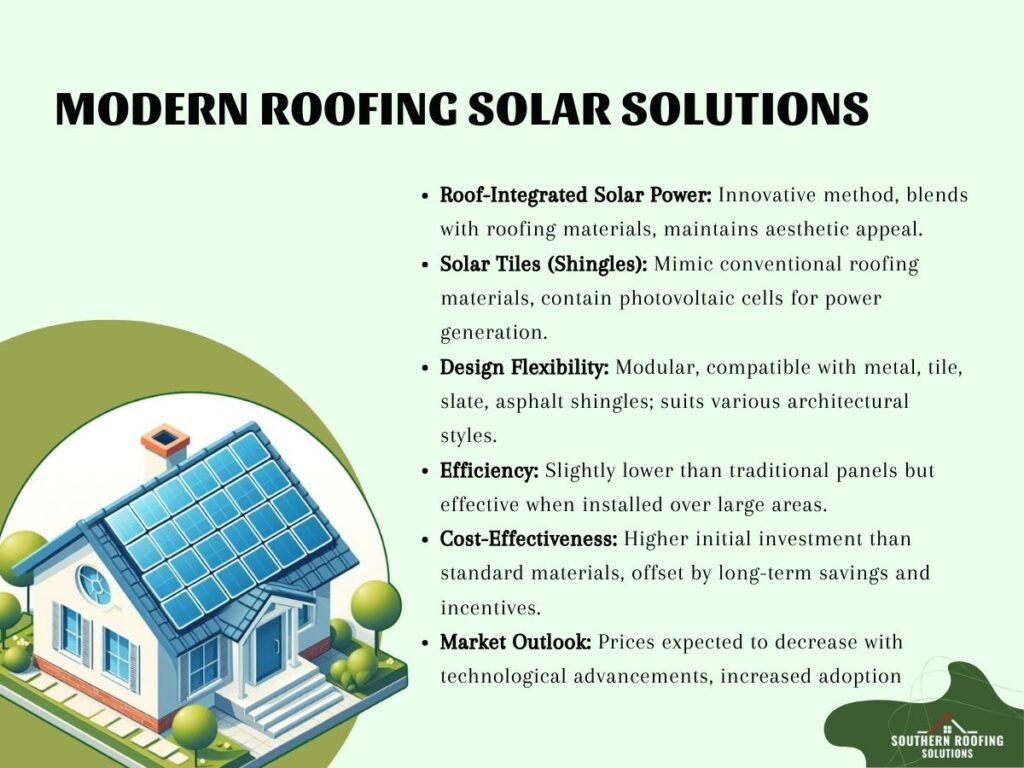The increased need for sustainable energy options has led to a rise in the popularity of solar panels in Huntsville. With the help of roof-integrated solar systems, you can now use solar energy to power your home sustainably and cleanly.
In recent years, solar roofing systems have demonstrated many advantages for US consumers and businesses. Modern solar equipment increases your home's energy independence, tax benefits, and resale value while lowering energy expenses.
Although the benefits of solar energy have been established, some obstacles have prevented the broad use of typical solar panel installations. Many homes and businesses have unique roof designs—such as flat roofs, curved roofs, or roofs with multiple slopes—that make it difficult to mount traditional solar panels. So how do yo integrate solar panels with traditional roofing in Huntsville? Let's have a look!
Traditional solar panel installation involves a number of challenging processes, including drilling holes in the roof, which concerns some homeowners about possible roof damage or water leakage.
Understanding the compatibility of solar panels with different roofing materials is an important step in the integration process, as the installation process can be laborious and complicated depending on the chosen roofing material.

Metal roofs are well-suited for solar panel integration due to their longevity and resistance to weathering, creating a stable foundation for mounting solar arrays. Furthermore, by reducing heat absorption, metal surfaces' reflecting qualities can raise the total energy efficiency of solar panels.
However, when considering metal roofs for solar integration, it's important to differentiate between various metal roof profiles since some are easier to install solar panels on than others.
Adjustable brackets, clamps, and flashing systems must be selected based on the specific characteristics of the metal roof to prevent issues such as water infiltration and corrosion over time. Incorporating weather-resistant coatings on the solar panels and sealing any mounting holes with sealant ensures the durability of the overall system.
Since clay tiles are delicate and costly, removing them to install solar panel roof mounts may leave your roof vulnerable to water damage. Up until recently, installing solar panels on a roof with clay tiles was more expensive and risky than installing solar panels on a roof with metal or composite shingles.
Because the tiles are heavy in the first place, determining the roof's load-bearing capacity is necessary to prevent damage to the roof structure. Adjustable mounting brackets are used to integrate solar panels with tile roofs because they can be made to suit the curves of the tiles precisely, maintaining the visual uniformity of the roof while enabling exact solar panel placement.
With their planned placement around mounting points to securely seal around penetrations, flashing systems made for tile roofs further help in weatherproofing. Using a double flashing technique rather than hooks is advised since the more delicate clay tile may shatter due to the panels and hooks rattling slightly in the wind.
A detailed structural analysis is necessary before installing solar panels on slate roofs since the added weight of the solar panels will require the roof's weight-bearing capabilities to be properly checked. Given the fragile nature of slate, successfully installing solar panels onto slate roofs also calls for caution.
It's likely that conventional mounting solutions won't work and that the roof will need to be reinforced. For installation, non-penetrative techniques such as ballasted mounts are required to preserve the integrity of each tile.
To avoid breaking or chipping the tiles, contractors must be careful when installing them. Appropriate flashing systems and weatherproofing techniques should be used to guarantee the slate roof's lifespan and the solar installation.
Beyond the prominent roofing materials like metal, tile, and slate, various other roofing materials, such as asphalt shingles, wood, and composite materials, present their unique challenges and opportunities for solar panel integration.
Regardless of the roofing material, determining the load-bearing capacity of the roof ensures that the integration process does not compromise the overall stability of the structure. Surface texture also plays a role in the effectiveness of solar panel installations since smooth surfaces may allow for more straightforward mounting, while textured surfaces may require additional considerations.
The introduction of adaptable roof-mounted solar panels has completely changed the solar energy market because they are made to overcome the drawbacks of traditional installations and work with almost any kind, form, or roof orientation.
Versatile roof-mounted solar panels, in contrast to traditional panels, require no drilling holes in the roof to be installed on flat, sloping, or inclined roofs. This quick and easy installation removes the possibility of roof damage or water leaks.

When installing solar panels on sloped roofs, you need to consider sunlight exposure as well as ensure the structural integrity of the roofing system. The slope of the roof significantly influences the efficiency of solar energy capture, making roof pitch, orientation, and the choice of appropriate mounting systems important.
South-facing roofs are frequently exposed to the most sunshine during the day, which maximizes energy output. However, solar panels can still be effectively installed on east or west-facing slopes with adjustments in the tilt angle to capture sunlight during specific periods.
Common mounting options include roof attachment brackets, rail systems, and adjustable mounts, which help in finding the optimal tilt angle for maximum sunlight exposure and energy production. Roof attachment brackets secure the panels directly to the roof surface, while rail systems elevate the panels above the roof, providing an adjustable framework.
Sloped roofs present specific waterproofing and weatherproofing challenges, and proper flashing systems and sealants around mounting points help mitigate the effects. Sloped roofs often feature elements such as dormers, chimneys, or skylights that may cast shadows or impact the available space for solar panels.
Tailored alternatives, including staggered panel layouts or innovative design strategies, can be used to get around these characteristics and make the most use of the available roof area.
Installing solar panels on flat roofs seems easier than sloped roofs, but they, too, present unique sets of challenges and considerations. The absence of natural drainage and the need to optimize sunlight exposure requires a specialized approach to mounting systems, structural assessments, and maintenance considerations.
Flat roofs often have lower load-bearing capacities compared to sloped roofs, which is why an assessment of the roof's ability to support the added weight of solar arrays, mounting systems, and any additional ballast or racking is required. Ballasted mounts and racking systems are common solutions for flat-roof solar installations.
Ballasted mounts use the weight of concrete blocks or other heavy materials to secure the solar panels without penetrating the roof surface. Racking systems, on the other hand, provide an adjustable framework, allowing for precise panel placement and tilt angles.
Appropriate waterproofing techniques are needed to stop leaks and preserve the longevity of the solar installation and the roof because flat roofs lack natural water drainage and may collect debris like leaves.
Unlike sloped roofs with inherent tilt angles, flat roofs require an intentional approach to optimizing sunlight exposure. The tilt angle of solar panels on flat roofs can be adjusted using racking systems to ensure maximum sunlight capture throughout the day and across different seasons.
Modern roofing solar systems, which offer both efficiency and aesthetic appeal, have arisen as creative options as the demand for solar energy integration grows. Roof-integrated solar power is an innovative new method of harnessing solar power and converting it into clean, renewable energy for your home.

Roof-integrated solar panels are made to mix perfectly with your current roofing materials, unlike regular solar panels, which are frequently large & unappealing In other words, you may take use of solar energy's many advantages without compromising your home's visual beauty.
Solar tiles, also known as solar shingles, are made to resemble conventional roofing materials with the added benefit of using solar energy. Photovoltaic cells embedded in these tiles allow sunlight to be converted into electrical power.
Solar tiles are modular in nature, allowing for design flexibility, and can, therefore, be integrated with various roofing materials, including metal, tile, slate, and asphalt shingles. This adaptability makes them a viable option for various architectural styles and preferences.
Though perhaps not as efficient as regular solar panels, solar tiles can nevertheless generate electricity rather effectively. When solar tiles are widely installed over a sizable surface area, the cumulative effect can greatly increase the amount of energy produced overall.
The long-term energy bill savings and other incentives can more than makeup for the greater initial cost of solar tiles compared to typical roofing materials. Prices for solar tiles are predicted to rise as economies of scale and technological advancements take effect.
Adaptable roof-mounted solar panels have increased the accessibility and attraction of solar electricity for both residential and commercial sectors by removing the installation challenges that come with standard panels. This ground-breaking technology, which also enables people to accept renewable energy, accelerates our progress toward a sustainable and ecologically friendly future.And what better way to know the role of your roof in energy efficiency than to install solar tiles or adapt your roof to modern solar roofing solutions? You can significantly reduce energy costs and carbon emissions by modifying the material, color, ventilation, insulation, and design of your roof.